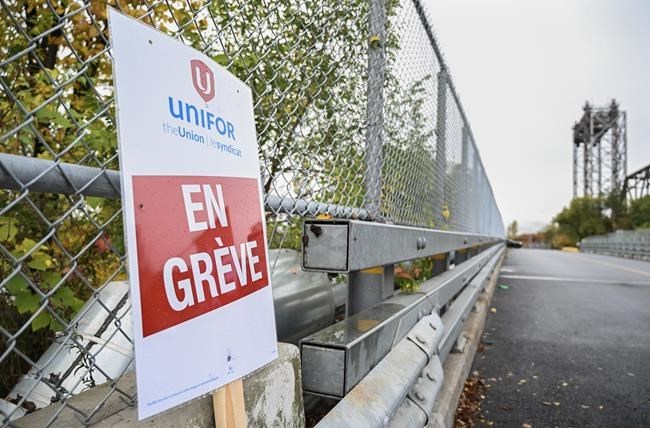MONTREAL ŌĆö The federal government has instructed workers and management in the St. Lawrence Seaway strike to sit down with a mediator this Friday and hash out their differences, as groups ranging from grain farmers to steelmakers feel the squeeze.
The job action by 361 Unifor members at 13 of the 15 locks along the key trade corridor kicked off Sunday, shutting it down immediately. The union and management authority both said on Tuesday they would comply with the government notice for mediation.
In the meantime, producers continue to fret.
Crosby Devitt, who heads Grain Farmers of Ontario, said the majority of crops yielded by the 28,000 producers he represents are exported as farmers wrap up the soybean harvest and begin to reap corn.
ŌĆ£ItŌĆÖs a huge impact," he said.
ŌĆ£ItŌĆÖs like a chain reaction. As it stops at the port, there's terminals all along the Great Lakes and along the St. Lawrence River ... They'll get full of grain, and then it backs up to the farm and potentially can be sitting in the field, subject to wildlife damage ŌĆö or snow soon enough ŌĆö moisture and rotting."
Devitt said there is no export alternative to the seaway, which runs between Lake Erie and Montreal and carried $16.7 billion worth of cargo last year ŌĆö nearly half of it grain and iron ore.
The St. Lawrence Seaway Management Corp. has applied to the Canada Industrial Relations Board for an exception on the transport of grain, a request that if granted would see the commodity flow through the artery despite the strike.
Federal cabinet ministers had been urging both sides to resume negotiations. Representatives from Unifor and the seaway last met minutes before the strike began at 12:01 a.m. on Sunday morning.
"They're meant to figure this out," Labour Minister Seamus O'Regan told reporters in Ottawa on Tuesday.
ŌĆ£ŌĆśIŌĆÖm saying that IŌĆÖll use every frigginŌĆÖ device in the Canada Labour Code that I can find to make sure that they do a deal at the table, because that's the ones that are sustained.ŌĆØ
The full Great Lakes St. Lawrence Seaway system, also known as "Highway H2O," serves over 100 ports and commercial docks and helps Canada's Prairie provinces and the U.S. Midwest export goods. Grain, iron ore, stone, petroleum products, cement and coal are among its key commodities.
The seaway alone supported some 66,600 jobs and $12.3 billion in economic activity last year, according to a July study by U.S.-based marine economic analysis firm Martin Associates and commissioned by industry stakeholders.
The broader Great Lakes St. Lawrence Seaway system supports $46.8 billion in economic activity annually, the study said.
Algoma Central, the biggest domestic ship operator on the Great Lakes, has said many of its boats are now docked, waiting to haul iron ore to mills in Hamilton where it will be turned into steel for the auto industry.
Fertilizer Canada CEO Karen Proud said distributors and retailers are also concerned about the effective freeze on imported crop nutrients, which need to be on store shelves by early spring for planting season.
ŌĆ£ItŌĆÖs the farmer that is suffering,ŌĆØ she said. "With all thatŌĆÖs going on in the world right now, Canada has to be a reliable partner."
Factories in Central Canada are hard hit as well, said Dennis Darby, CEO of the Canadian Manufacturers and Exporters industry group.
"If those boats are stuck in the queue, that starts to affect companies right away," he said, noting that Ontario and Quebec churn out roughly three-quarters of Canada's manufacturing output.
"If you're a company in southern Ontario building a large machine or components for machines that are going to Europe ... you've been affected."
Shipments of stone, cement and gypsum bound for construction sites in the Greater Toronto Area are in limbo too.
"We have a lot of traffic moving into the GTA for construction purposes. ThatŌĆÖs very important in a climate where we need more housing,ŌĆØ said Bruce Burrows, CEO of the Chamber of Marine Commerce.
Beyondthe bustle of Toronto development, remote communities in the Far North depend on autumn shipments of essential goods to sustain them through the coldest months of the year.
ŌĆ£Kerosene and other essential products are taken in during the sealift season, put into storage and hopefully that gets them through the winter. But in this case, if they can't fill up their storage adequately, can you imagine the cost of moving kerosene by air?" Burrows asked.
The seaway shutdown is costing the economy roughly $100 million in lost revenue daily, he claimed.
ŌĆö With files from Mia Rabson in Ottawa
This report by The Canadian Press was first published Oct. 24, 2023.
Christopher Reynolds, The Canadian Press



